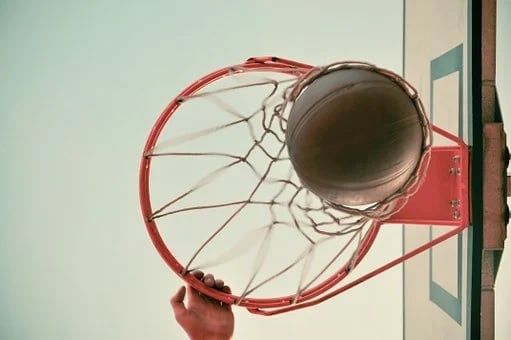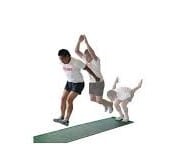
How Tall Do You Have To Be To Dunk A Basketball? You do not have to be a specific height to dunk a basketball, although there is scant evidence to suggest that people shorter than 5’7” have enjoyed meaningful success trying to dunk a basketball.
To the contrary, there is overwhelming evidence of people taller than 6-feet being able to not only dunk a basketball but also to dunk a basketball comfortably. If you want to be a competitive basketball player, being taller than 6-feet probably means you could dunk in your sleep.
You can certainly get away with being a little shorter than 6-feet tall in that competitive environment but there is unlikely to be an overwhelming amount of dunking either - not because you are unable to dunk but because the people blocking your dunk are probably going to be taller than you.
If you are a lot shorter than 6-feet tall, there isn’t going to be a whole lot of dunking, PERIOD! The basketball hoop is 10-feet high and there is just so much of a height deficit to overcome.
Factors That Determine How Tall To Dunk A Basketball
1- Standing Reach
When trying to determine how high you need to jump before Dunking A Basketball, you need to establish what your standing reach is. We could try and get fanciful with the wording, but ultimately your standing reach is how far you can reach into the air with your hands, while standing flat-footed on the ground.

The easiest way to determine this will be by standing next to a wall or any other effective marking device, stretching your arm into the air and recording the highest height you managed to touch.
Once you know what your standing reach is, you can then calculate the deficit which you will need to make up for, by operating under the probable assumption that the basketball hoop is 10-feet high.
Given that there is no recorded history of a man ever being that tall (3m), every single one of you reading this blog will need to make up for some standing reach deficit, when trying to dunk a basketball.
2- Vertical Jump
The Vertical Jump is the difference in the height of your jump and the height of your standing reach. It therefore stands to reason that the taller you are, the lower your vertical jump needs to be - whether you are just trying to reach the rim or trying to dunk a basketball.
Those of us who do not enjoy those genetic advantages, need to find a way to jump higher.
However, you will often find that these freakishly tall athletes are also outstanding jumpers because they know they are not the only tall basketball players on the court.

The nature of elite competition dictates that some people will need to try and increase their Vertical Jump anyway, which is why there are standard measures of what a good vertical jump is vs an excellent vertical jump.
Certainly, at an amateur level, being a tall basketball player can be an overwhelming advantage...not to be taken lightly. For amateurs, achieving a higher jump is not placed on the same premium as it is at a professional level. Being born tall counts a lot more at junior level.
3- Jumping Power
Vertical Jump Testing is also a form of measuring the amount of explosive power you are able to generate when jumping. Your Average Vertical Jump will likely improve, the more jumping power you are able to produce.
The more explosive power you are able to store and release, the higher your vertical will be.
The higher your vertical is, the greater the likelihood of you dunking a basketball. You might have already caught onto this by now, but the height of your vertical jump and the power you are able to generate are directly related and they are collectively more important than any other facet of dunking a basketball.
Dunking Difficulty Per Height
As a point of departure, the important point to make here is that short people have not only been known to dunk a basketball, but they have also been known to dunk a basketball with considerable aplomb too.
Be in no doubt that these athletes have had to put in the hard yards, before achieving those jumping objectives but there has never been such a thing as a free lunch.
Nothing is ever handed to you in life, not even on the basketball court! With the right attitude, you can overcome whatever height deficit you have and still dunk a basketball.
The message of hard work is just as relevant for those among you who are taller than the Average Joe, though. Just because you are tall, does not mean that you are the only tall basketball player on the planet. You need to work equally hard just to compete against your peers.
There is alway incentive to work hard in sport, even if the “official” jumping targets may vary.
The table below is an indicator of the mental fortitude you will need to overcome the difficulties associated with jumping higher and dunking, based on how tall you are.
Dunking Difficulty | Height | ||
|---|---|---|---|
|
| ||
|
| ||
|
| ||
|
|
Testing Your Vertical Jump Height
The hard work we mentioned above is completely useless if you do not have more clarity on what vertical jump targets you need to set before jumping higher.

The table below is a guideline to what bracket you might feel you fall into. There are calculating options available for those who seek a little more specificity with the data. But this table remains a useful guide.
|
|
| |||
|---|---|---|---|---|---|
|
|
| |||
|
|
| |||
|
|
| |||
|
|
|
So, How To Dunk Anyways?
There are two basic facets that make the act of dunking a basketball more unique than any other scoring method.
The first is that the player should be in control of the basketball right until it is directly above the rim
The second is that the basketball is drained through the hoop without the assistance of the backboard or another player
1- Jump High Enough To Reach The Basketball Hoop
Neither of those objectives can be realized if the person dunking the basketball does not know how to jump high enough for his fingers to be above the rim of the basketball hoop, at the very least.
The best dunkers of a basketball are able to jump high enough for the entire hand and even part of the arm to be safely above the height of the rim. However, as we have already pointed out, your primary goal is jumping high enough just to get those fingers above the rim.
We have already established that the standard basketball hoop is 10-feet above the ground.
You can only know how much you need to jump before dunking, once you have established what your vertical jump is. In most cases, you only know what your vertical jump is, after establishing what your standing reach is.
In essence, figuring out how much higher you need to jump, will hinge heavily on how tall you are. The table we have inserted above will provide meaningful guidance on which bracket you fit into.
2- Dunk A Basketball With One Hand
For those who are bold enough to do it, there are two ways to dunk a basketball with one hand.
The safest way to dunk a basketball with one hand - which is probably the best method for those still learning to dunk a basketball - is to do so by scooping the basketball from below and keeping the palm of your hand facing up, right up to the point where the hand is above the hoop or rim.
In our intro to this section we mentioned the one unique thing about dunking a basketball in general was the fact that the player needs to be in control of the ball right until the hand is safely above the hoop, before draining that ball through the hoop.
The most effective way to stay in full control is that basketball is by scooping it from below when you take-off into the air to dunk, especially if you're a beginner or worse still a short player.
You could also dunk a basketball with one hand, by gripping it with the palm of your hand facing down - although we do strongly advise against it, especially if you are a beginner or a short player.
The thing about short players is that they invariably have pretty small hands too, although we acknowledge that is not a particularly scientific observation.
However, the logic still stands that having a smaller pair of hands makes it increasingly difficult to grip a basketball, especially with the palm faced down. Beginners, even those with big hands, will struggle to grip a basketball with one palm.
However, if you are an advanced and confident player - with bigger hands than everybody else - then dunking a basketball with one hand can be a most agreeable alternative.
3- Dunk A Basketball With Two Hands
Dunking a basketball with two hands can be construed as a safe and effective option, especially for those who are either very tall or have exceptional jumping abilities. Some people trying to jump higher need to use at least one of their arms to help propel themselves into the air.
Many people who opt to dunk a basketball with two hands, also take off from the ground with two feet - which can be complicated in and of itself. If you are not an advanced and confident jumper...or if you are short, we do not think this option is for you.
4- Jump Off One Foot To Dunk
Jumping off one foot to dunk a basketball can offer you a little more freedom, and more room to propel yourself into the air but that will come at a cost. By dunking a basketball off one foot, you compromise on control and stability, especially while you are in the air.
5- Jump Off Two Feet To Dunk
Jumping off two feet to dunk is an option for those who are not confident about their capacity to generate explosive power off just the one leg. It is also an agreeable alternative for those who worry about core stability while they are in the air, having taken off from one foot.
For the most part, jumping off two feet to dunk a basketball is definitely the more reasonable of the options that are available to you. However, that can also come at a price, if you are not careful.
Managing the final steps and strides before you take off can be complicated, as is the problem of trying to maintain the momentum and velocity that you have built up before jumping off two feet to dunk a basketball.
Conclusion
Instead of asking how tall you need to be to dunk a basketball, rather try and establish how much ground you need to make up before dunking.
While being shorter than most will mean there is a considerable amount of ground to make up, before you can dunk, that does not mean the task is impossible or that it cannot be achieved.
The key is grasping where you fit into the greater scheme of things and understanding what it is going to take to defy the odds, if they happen to have been stacked against you.
Hey, I’m Aleksandar and I am a Basketball freak! That is why I decided to create this blog. Teaching people How to dunk a basketball and How to Jump Higher in this sport or other related sports that require vertical jumping, is my specialty. If that’s your aim, then you have come to the right place.
